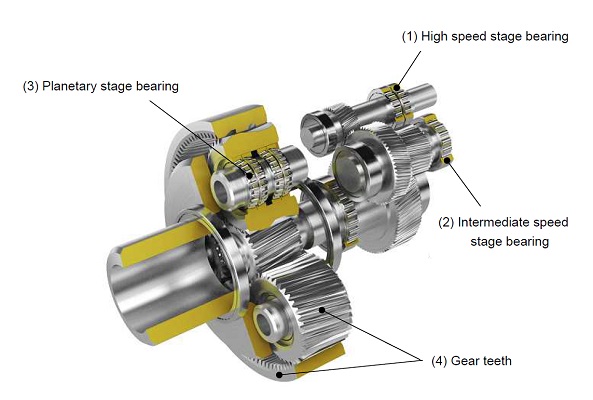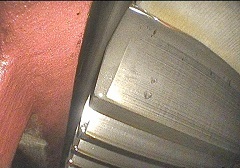![]()
1. Background
Wind turbines are an efficient and growing source of renewable energy, but due to complexity of the interior machinery—gearboxes in particular—they need regular inspection to prevent damage, downtime and even fires. Videoscopes that are used to carry out gearbox inspections need to operate under the dark, reflective and oily conditions of wind turbine gearboxes. Under these conditions, manoeuvrability, smart illumination control, and high-quality optics are critical parameters that determine inspection efficiency, speed and reliability.
Here, we explore the challenges of wind turbine inspections and recent innovations to save time and improve quality. A case study will highlight how Danijel Bogojevic, operations manager at ALL NRG, has used different features of the IPLEX RX to reduce inspection times and improve probability of detection in gearbox inspections.
Wind power is a vital and growing source of clean renewable energy. In 2015, the EU generated an estimated 11.4% of its energy from wind – and more growth is expected as a result of the EU’s binding target of 20% renewable energy in 2020.
Commercial wind turbines can be operational for over 20 years. During the lifetime of a turbine there are many factors that can cause damage, either gradually or suddenly. Frequent reasons for wind turbine damage include corrosion, moisture, lightning strike and material loss in the machinery.
The gearbox of a wind turbine is a particular area of concern. A combination of high speeds, stresses and strains means that the specifications for the materials that can be used in gearboxes are highly specific and that damage to any of the components can easily affect other parts of the machinery. For example, loss of a metal fragment of one component can lead to debris becoming trapped in gear teeth or bearings, causing further damage.
In order to prevent escalating damage and costly repairs, continuous monitoring systems are installed to detect early warning signs of damage. An example of continuous monitoring is the installation of vibration sensors; vibration is a common indicator of minor faults that have the potential to develop into more serious and costly damage.
2. Improving Turbine Lifetime With Gearbox Inspections
To address these early warning signs and as a routine precaution, wind turbine gearboxes are regularly inspected to avoid repairs and downtime and to ensure a long lifespan. Videoscopes are used to access the inner parts of the gearbox and to obtain high-quality images of the inaccessible areas that are prone to damage.

Figure 1: Overview of a wind turbine gearbox.
The interior of the gearbox consists of a series of transmissions that convert the low-speed rotation driven by the blades into a high-speed rotation that drives the generator (figure 1). Components can be damaged due to vibration, foreign matter, air or moisture contained in the lubrication oil. Important areas for inspection include:
- The planetary stage bearings and planetary gear, which provide support to the low speed shaft. The shaft only rotates at around 20 to 30 revolutions per minute (rpm), but when the weather conditions are variable, the planetary bearings need to absorb the significant stresses applied through the shaft. The structure of the planetary gears is complex and its location within the gearbox makes it difficult to access with inspection equipment.
- Intermediary stage bearings support the intermediary shaft and are located at the front and the back – directly below the other shafts. Intermediary bearings are difficult to inspect, mainly due to their location.
- High speed stage bearings are easier to access during an inspection, but are more likely to be damaged due to their high speed of between 1,500 and 1,800 rpm. Furthermore, this high speed also means that damage to the high speed bearings is more likely to affect other parts of the gearbox.
3. Challenges of Gearbox Inspections
The conditions inside the gearbox of a wind turbine provide some of the most difficult challenges for videoscope technology. There are several factors that have to be considered in the design of videoscopes to cope with these conditions.
- Manoeuvrability. In order to effectively inspect a gearbox using a videoscope, the tip of the scope has to pass through several openings, which are only slightly smaller than the diameter of the tip itself. For example, when a 3.8 mm tip passes through holes of between 4.4 and 6 mm the risk of lens contamination can be significant.
- Low light conditions. Many of the deep or concealed features of the gearbox need to be inspected in very low light conditions. This means that the videoscope’s light source needs sufficient power to illuminate large, dark spaces.
- Glare. When inspecting shiny metallic or oily surfaces, glare can cause difficulties in detecting faults on the surface of the component, due to the high amount of reflected light.
- Oil contamination. Oil is essential for lubrication when the turbine is in operation. During inspection however, the tip of the scope can come into contact with oil; this can affect image quality and may require the scope to be retracted for cleaning.
- Depth of field. During an inspection, moving through the gearbox is easier with a near focus lens, whereas imaging of large spaces works better with a far focus lens. As the tip cannot be replaced inside the gearbox, high depth of field can provide a combination of speed and image quality.
- Portability. The nature of wind turbine inspection work means that videoscopes have to be carried on high ladders and through narrow openings.
4. Saving Time and Improving Image Quality
The Olympus IPLEX RX is equipped with a range of features designed to make videoscope inspections of wind turbine gearboxes faster and clearer. The combination of high-quality optics, innovative software and hardware solutions and portability has made the IPLEX RX a reliable choice for the wind power industry.
Oil-clearing Tip Adapter
Specifically designed to save time in confined oily spaces, the unique oil-clearing tip adapter (figure 2) can be used to navigate through oil-covered openings and near oily surfaces. When a conventional tip comes into contact with oil, it produces blurred images, making it necessary for the inspector to retract the tip for cleaning.
In order to overcome this challenge, the oil-clearing tip features narrow grooves. If oil gets on the lens, capillary action draws the oil away from the lens into the grooves, enabling the operator to continue the inspection unhindered.

Figure 2: The oil-clearing tip adapter features narrow grooves around the lens that draw fluid away from the surface of the lens.
Intelligent Illumination
The combination of inspecting dark, hollow spaces and inspecting highly reflective surfaces creates a huge challenge when it comes to illumination. These conditions require intelligent illumination control to improve contrast and probability of detection.
The IPLEX RX is equipped with a PulsarPic image processor, which automatically optimises light, reduces noise and sharpens images. These functions allow the IPLEX RX to balance brightness and clarity and increase probability of detection in gearbox inspections.
Power-assisted Mechanical Articulation
Articulation of the scope tip determines how fast an inspector can access hard-to-reach areas and components. Due to the large size of the gearbox and the many obstacles, smooth, responsive and precise articulation will be a significant time-saver in this type of inspection.
Using the TrueFeel power-assisted manual articulation of the IPLEX RX inspectors can achieve optimal hand-eye coordination. Intuitive manual control enables the inspector to move through narrow holes and openings for easier and faster inspections.
5. Case Study: Inspecting Gearboxes at ALL NRG
The ALL NRG Group A/S offers installation and inspection to both onshore and offshore energy companies. Based in Denmark, it employs specialist wind turbine inspectors, each carrying out up to several hundred inspections annually.
Danijel Bogojevic is an inspector at ALL NRG who has carried out over 1,000 gearbox inspections using different videoscopes (figure 3). “Endoscopic inspection is the only way to properly inspect a gearbox or any other bearing,” Danijel explained, “Olympus is without a doubt my favourite brand. I have carried out a large number of inspections over the last few years and the change in quality when I replaced my previous videoscope with the IPLEX RX was amazing.”

Figure 3: ALL NRG inspector Danijel Bogojevic carrying out a gearbox inspection with the IPLEX RX.
The switch to IPLEX has improved inspection on many levels for ALL NRG. Danijel commented: “With the IPLEX RX, optical performance and light output have significantly improved compared to my previous videoscope. The illumination is so much higher, which means that I can instantly see where I want to go. On top of this, orientation is easier, which makes navigation faster and inspection times much shorter” (figure 4).


Figure 4: Intelligent illumination helps to prevent glare from metallic surfaces, making it easier to detect a damaged bearing.
The optical quality of the lens has made a significant contribution to the inspection workflow at ALL NRG. As Danijel pointed out: “I used to have to change between a near focus and a far focus lens depending on what I was looking at. With the IPLEX RX I can simply use the near focus lens for everything as the depth of field is far superior” (figure 5).

Figure 5: Using lenses with a high depth of field allows inspectors to inspect large or deep spaces more quickly.
Danijel was also impressed with the oil-clearing tip adapter, and recalled a particular instance; “I was hired to inspect a gearbox on a NEG-Micon 72/2000 wind turbine in Overgaard Wind Park in Denmark. I used the opportunity to test the new adapter solution in conjunction with the IPLEX RX. I can clearly see the benefit; when you’re trying to reach difficult, oily places it could save you a lot of time. This would also be a particularly good solution for new and inexperienced inspectors, as it would mean they could continue to capture images, even after coming into contact with oil” (figure 6).

Figure 6: Gear teeth
6. Summary
Regular gearbox inspections are a cost-effective way to ensure low downtime of wind turbines and to prevent minor faults from resulting in costly gearbox replacements. Comprehensive gearbox inspection would not be possible without the use of sophisticated, portable videoscopes to view hard-to-reach areas, such as bearings and gear teeth.
Image quality and overall inspection time are the critical parameters that ensure cost-effective inspection with a high probability of detection – and the smart features on the IPLEX RX have a significant impact on both at ALL NRG. As Danijel simply puts it: “Resolution and quality of the pictures make both me and my clients happy. Using the IPLEX RX, I have halved my inspection time to two to three hours – and upgraded the quality of my reports.”


